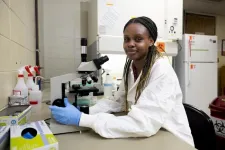(Press-News.org) UNIVERSITY PARK, Pa. — American diets may have gotten healthier and more diverse in the months following the start of the COVID-19 pandemic, according to a new study led by Penn State researchers.
The study — published in PLOS ONE — found that as states responded to the pandemic with school closures and other lockdown measures, citizens’ diet quality improved by up to 8.5% and food diversity improved by up to 2.6%.
Co-author Edward Jaenicke, professor of agricultural economics in the College of Agricultural Sciences, said the findings provide a snapshot of what Americans’ diet and eating habits might look like in the nearly complete absence of restaurant and cafeteria eating.
“When dine-in restaurants closed, our diets got a little more diverse and a little healthier,” Jaenicke said. “One post-pandemic lesson is that we now have some evidence that any future shifts away from restaurant expenditures, even those not caused by the pandemic, could improve Americans’ food diversity and healthfulness.”
Prior to the pandemic, the researchers said, the average U.S. diet was considered generally unhealthy. According to the Dietary Guidelines for Americans, eating patterns in the U.S. have remained far below the guidelines’ recommendations, with only slight improvements in the population’s average Healthy Eating Index score between 2005 and 2016.
Also, before the pandemic, the research team was in the midst of a grant-funded project that asked how people would feed themselves after a giant global catastrophe, such as an asteroid strike or nuclear war. In particular, Jaenicke’s team was tasked with investigating how consumers and food retailers might behave during such a disaster.
“At first, the most impactful events we could study using actual, real-world data were hurricanes and other natural disasters,” Jaenicke said. “But then, along came the COVID-19 pandemic, and we realized that this event was an opportunity to study the closest thing we had to a true global catastrophe.”
For the study, the researchers analyzed data from the NielsenIQ Homescan Consumer Panel on grocery purchases, which includes 41,570 nationally representative U.S. households. Data consisted of the quantity and price paid for every universal product code each family purchased during the study period.
Data was gathered from both before the pandemic hit and after the pandemic led to schools, restaurants and other establishments temporarily closing. Because states did not respond to the pandemic simultaneously, the researchers designated each household’s post-pandemic period as the weeks following the date that their county of residence closed schools in 2020.
Jaenicke noted that this allowed the team to show a true causal effect of the pandemic school closures, which generally occurred around the same time that restaurants and other eateries also closed.
“To establish causality, an individual household’s pre- and post-pandemic food purchases were first compared to the same household’s food purchases from one year earlier,” Jaenicke said. “This way, we controlled for the food-purchasing habits, preferences and idiosyncrasies of individual households.”
The researchers found that in the two to three months following pandemic-based school closures — spanning March to June 2020, depending on the specific U.S. state — there were modest increases in Americans’ food diversity, defined as how many different categories of food a person eats over a period of time.
They also found larger, temporary increases in diet quality, meaning the foods purchased were healthier. This was measured by how closely a household’s purchases adhered to the U.S. Department of Agriculture’s (USDA) Thrifty Food Plan, which was designed to meet the requirements of the recommended healthy diet according to the Dietary Guidelines for Americans.
These patterns were found across households with many different demographics; however, those households with young children, lower incomes and without a car exhibited smaller increases in these measures.
“During the COVID-19 pandemic, dine-in restaurants closed, schools and school cafeterias closed, and many supermarket shelves were empty,” Jaenicke said. “Since about 50% of Americans’ food dollars are spent on ‘away from home’ food from restaurants and cafeterias, the pandemic was a major shock to the food system.”
The researchers said there are several possible explanations for these findings. First, because other studies have found that food from restaurants is often less healthy than food made at home, the dramatic decrease of meals eaten at and purchased from restaurants during the pandemic could have contributed to an increase of food diversity and healthfulness at home.
Second, they said it was possible that a global pandemic triggered some consumers to become more health conscious and contributed to them buying healthier, more diverse groceries. Third, because the pandemic caused widespread disruptions to the supply chain, it’s possible that when familiar products were sold out, consumers shifted to newer ones that led to increased diversity and healthfulness.
Finally, school and business closures may have led to many households having more time to cook and prepare foods than they had before, while others — like those with small children — may have had less free time than pre-pandemic.
Jaenicke said that in the future, additional studies could continue to explore how different disasters affect purchasing and eating habits.
Douglas Wrenn, associate professor of environmental and resource economics at Penn State, and Daniel Simandjuntak, research associate at Newcastle University, were also co-authors on the study.
Open Philanthropy helped support this research.
END
American diets got briefly healthier, more diverse during COVID-19 pandemic
2024-07-15
ELSE PRESS RELEASES FROM THIS DATE:
Media Tip Sheet: Symposia at ESA2024
2024-07-15
The latest ecological research will be on full display at the Ecological Society of America’s upcoming Annual Meeting in Long Beach, California, Aug. 4–9. A focal point of the conference, symposia consist of four 20-minute talks organized around a central theme of broad interest. These sessions consider topics from different angles, integrate multiple lines of evidence and offer new insights on ecological phenomena.
This year, Annual Meeting symposia will address nonmaterial (“cultural”) ecosystem services, nature-based solutions to problems like stormwater runoff and urban heat, ...
Making rechargeable batteries more sustainable with fully recyclable components
2024-07-15
UNIVERSITY PARK, Pa. — Rechargeable solid-state lithium batteries are an emerging technology that could someday power cell phones and laptops for days with a single charge. Offering significantly enhanced energy density, they are a safer alternative to the flammable lithium-ion batteries currently used in consumer electronics — but they are not environmentally friendly. Current recycling methods focus on the limited recovery of metals contained within the cathodes, while everything else goes to waste.
A team of Penn State researchers may have solved this issue. Led by Enrique Gomez, interim associate dean for equity and inclusion and professor of chemical engineering ...
Biodegradable electronics may advance with ability to control dissolve rate
2024-07-15
UNIVERSITY PARK, Pa. — Biodegradable electronics allow for medical devices — such as drug delivery systems, pacemakers or neural implants — to safely degrade into materials that are absorbed by the body after they are no longer needed. But if the water-soluble devices degrade too quickly, they cannot accomplish their purpose. Now, researchers have developed the ability to control the dissolve rate of these biodegradable electronics by experimenting with dissolvable elements, like inorganic fillers and polymers, that encapsulate the device.
The team, led by Huanyu “Larry” Cheng, the James L. Henderson, Jr. Memorial Associate Professor ...
Most Salmonella illnesses from chicken caused by few products with high levels of virulent strains
2024-07-15
URBANA, Ill. – Raw poultry is one of the main causes of Salmonella poisoning, which affects thousands of people in the U.S. every year. A new study from the University of Illinois Urbana-Champaign shows that few products with high levels of very virulent Salmonella strains are responsible for most of the illnesses from raw chicken parts. The researchers suggest regulation efforts should focus on detecting and preventing those types of high-risk contamination.
“Over the last 20 years, the poultry industry has done a really good job of lowering the frequency of Salmonella in poultry. However, the number of people ...
Kenyan crop contamination outbreak inspires grad student to improve rice storage
2024-07-15
By Maddie Johnson
University of Arkansas System Division of Agriculture
Arkansas Agricultural Experiment Station
FAYETTEVILLE, Ark. — While half the global population relies on rice as a staple, about 15 percent of rice produced each year is contaminated by potentially fatal aflatoxins. Seeing this threaten lives in her home country of Kenya prompted a graduate research assistant to focus on eradicating the risk through safer storage methods.
Faith Ouma, a Ph.D. student in the food science department at the University of Arkansas, was the lead author of “Investigating safe storage conditions to mitigate aflatoxin contamination in rice.” It was published ...
Survey finds women in their 40s may choose to delay mammography when informed about the benefits and harms
2024-07-15
Embargoed for release until 5:00 p.m. ET on Monday 15 July 2024
Annals of Internal Medicine Tip Sheet
@Annalsofim
Below please find summaries of new articles that will be published in the next issue of Annals of Internal Medicine. The summaries are not intended to substitute for the full articles as a source of information. This information is under strict embargo and by taking it into possession, media representatives are committing to the terms of the embargo not only on their own behalf, but also on behalf of the organization they represent.
----------------------------
1. ...
CDI scientists ID ‘unconventional’ new pathway for TB vaccines
2024-07-15
An “unconventional” immune response now identified by scientists from the Hackensack Meridian Center for Discovery and Innovation (CDI) is a potential new pathway for developing new vaccines for tuberculosis (TB), according to a new publication.
Marginal zone B (MZB) cells are a natural response to TB infection which has been long overlooked - and which might be a welcome new target that could be bolstered through new vaccines to better combat and prevent the disease, according to the new publication in the journal Cell Reports.
“Our results indicate that B cells skew their immune landscape ...
Mendoza, Weiss receive $2.6 million grant to study biomechanics of lung tumors
2024-07-15
Michelle Mendoza, PhD, researcher at Huntsman Cancer Institute and associate professor of oncological sciences at the University of Utah (the U) and Jeffrey Weiss, PhD, professor of biomedical engineering and faculty member in the Scientific Computing and Imaging Institute at the U, are the recipients of a $2.6 million grant from the National Institutes of Health (NIH) to research how tension in lung tissue affects the growth and distribution of tumors. This innovative approach could uncover new mechanisms for understanding how lung cancer develops.
“There ...
Study shows how narcissistic CEOs influence the board of directors to take more risk
2024-07-15
Narcissistic CEOs that also serve as chair of the board are adept at controlling how their boards of directors focus their attention, giving the CEO the ability to get their way. A new study published in the Strategic Management Journal found that by driving board discussions about risk-taking to hold a positive tone, narcissistic CEOs can allocate more resources toward risk-taking strategies. The findings deepen our understanding of how CEO behavior and personality types can drive risk management strategies.
The research team — Christopher S. Tuggle of the University of Central Arkansas, Cameron J. Borgholthaus of the University of Wyoming, Peter D. Harms of the University of Alabama, ...
Study shows timely transition from pediatric to adult care is critical for young adults with sickle cell disease
2024-07-15
Sickle cell disease is the most common inherited red blood cell disorder in the United States and can lead to health problems including organ dysfunction, acute chest syndrome and strokes over a patient’s lifespan. According to a new study, individuals living with sickle cell disease who experience a delay of more than six months after transferring from pediatric to adult care are twice as likely to be hospitalized compared to those who transition in less than two months.
In the study, Kristen ...





